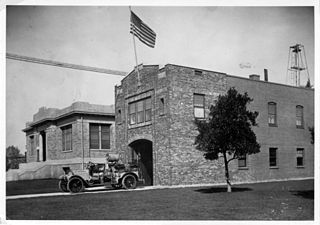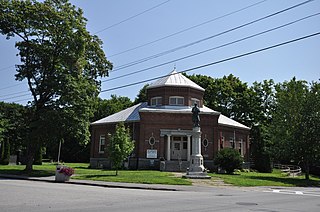
The Gratz Park is a neighborhood and historic district located just north of downtown Lexington, Kentucky. It was named after early Lexington businessman Benjamin Gratz whose home stands on the corner of Mill and New streets at the edge of Gratz Park. The historic district consists of 16 contributing buildings including the Hunt-Morgan House, the Bodley-Bullock House, the original Carnegie library in Lexington, and several other private residences. Gratz Park occupies a tract of land that was established in 1781 outside the original boundaries of Lexington.

The Oregon Public Library is located in Oregon, Illinois, United States, the county seat of Ogle County. The building is a public library that was constructed in 1909. Prior to 1909, Oregon's library was housed in different buildings, none of which were designed to house a library. The library was built using a grant from wealthy philanthropist Andrew Carnegie. The grant was obtained after Oregon's citizens voted to change Oregon's library from a city library to a township library. The building was completed by 1908 but the library did not begin operation until 1909.

The Arcola Carnegie Public Library is a Carnegie library located at 407 E. Main St. in Arcola, Illinois. The library was built in 1905 through a $10,000 grant from the Carnegie Foundation. Architect Paul O. Moratz designed the library in the Classical Revival style. The building's front entrance is situated within a Classical gabled portico supported by stone pilasters. The hipped roof of the building features an ornamental cornice along its edge and a cupola at its peak. The building still serves as Arcola's public library and houses a collection of over 18,000 books.

The Aitkin Carnegie Library is a Carnegie library in Aitkin, Minnesota, United States. It was designed by architects Claude & Starck and was built in the Classical Revival style. It was listed on the National Register of Historic Places in 1982.

The Oakland Public Library, serving the town of Oakland, Maine, is located at 18 Church Street, in an architecturally distinguished building designed by Harry S. Coombs in Classical Revival style and built in 1915. It was listed on the National Register of Historic Places in 2000. The library underwent a major renovation and expansion in 2003.

The Carnegie Free Library in Eureka, California was built in Classical Revival Style in 1902. It was listed on the National Register of Historic Places in 1986, and currently houses the Morris Graves Museum of Art.

The Carnegie Library in Anaheim, California is a Carnegie Library building built in 1908. The Classical Revival style building was designed by John C. Austin, and opened in 1909.

The Carnegie Library, historically known as the Upland Public Library, is a Carnegie library located at 123 East D Street in Upland, California. Built in 1913, the library was the first public building in Upland. Architect Homer W. Glidden designed the library in the Classical Revival style. The library's design features a projecting central entrance with a plain frieze supported by two columns and brick pilasters, a stucco parapet extending around most of the building, and a cornice set above dentils. The building served as a library until 1969, when the library moved to a new building. The City of Upland still owns the building and rents it to the public for community events. It is also used by the Upland Public Library to house its Literacy Program.

The Cherryvale Carnegie Free Library is a Carnegie library located at 329 E. Main in Cherryvale, Kansas. The library was built in 1913 through a $10,000 grant from the Carnegie Foundation. Architect George P. Washburn, who also designed eight other Carnegie libraries in Kansas, designed the library in the Classical Revival style. The red brick library has three bays in its facade. The library's recessed entrance is a classical pavilion with a brick frieze and supporting Tuscan columns and brick pillars; the doorway is topped with a limestone lintel. The low roof of the library is surrounded by a parapet.

The Eureka Carnegie Library is a Carnegie library located at 520 N. Main in Eureka, Kansas. The library was built in 1914 through a $9,000 grant from the Carnegie Foundation. The George P. Washburn Co. designed the building in the Classical Revival style. The red brick library has a facade with three bays. The library's main entrance is within a projecting pavilion topped by a keystone and two voussoirs; the doorway once had a transom which has since been covered. A limestone entablature encircles the building, and the windows feature brick lintels with limestone keystones.

The Cadillac Carnegie Public Library, now the Wexford County Historical Society Museum, was constructed as a Carnegie Library located at 127 Beech Street in Cadillac, Michigan. It was designated a Michigan State Historic Site in 1980 and listed on the National Register of Historic Places in 2007.

The Carnegie Free Public Library, also known as the Carnegie Town Hall, is a historic Carnegie library located at 235 W. 10th St. in Sioux Falls, South Dakota. The library was built in 1903 through a $25,000 grant from the Carnegie Foundation. Architect Joseph Schwartz designed the building, a Romanesque Revival structure with Neoclassical influences. The library was built from locally quarried quartzite, a popular local building material at the turn of the century. While the building's massive form and rough-hewn stone exterior are Romanesque, it features a Greek pediment above the entrance supported by four pilasters on either side of the doorway. The building represents the only use of Classical details in a quartzite building in Sioux Falls.

The Carnegie Library at Livermore, California, opened in 1911 and continued in use as a library until 1966. It now hosts a historical museum and art gallery. The building was designed by William H. Weeks in the Greek Revival style and is included on the National Register of Historic Places. A weekly farmers' market takes place in the surrounding park.

The Jacksonville Public Library is a Carnegie library located at 201 West College Avenue in Jacksonville, Illinois. The library was built in 1902 to house the city's library program, which began in 1870. Chicago architects Patton & Miller designed the Classical Revival building. The building still houses the city's public library and is listed on the National Register of Historic Places.

The Madison Public Library is located at 12 Old Point Avenue in Madison, Maine. Built with funding support from Andrew Carnegie, it is one of the architecturally most unusual libraries in the state, with a distinctive octagonal tower and non-rectangular angled elements. It was designed by the local firm of Snow and Humphreys and completed in 1906. The building was listed on the National Register of Historic Places in 1989.

The Kewanee Public Library is a Carnegie library located at 102 South Tremont Street in Kewanee, Illinois. The library was built in 1907-08 to house the city's public library, which was formed in 1875 and had previously occupied a room in the town hall. The city's first attempt at building a Carnegie library came in 1901, but it could not secure funding to match Carnegie's $20,000 grant; later in the decade, it approved additional community funding and convinced Carnegie to supply an additional $5,000. Chicago architects Patton & Miller, who were well known for their work on Carnegie libraries, designed the Classical Revival building. The library's design includes an entrance flanked by four stone columns and topped by a portico, stone pilasters to either side of the front windows, and a classical entablature with a frieze and dentillated cornice.

The Sioux City Free Public Library is a historic building located in Sioux City, Iowa, United States. The library was located in a section of the Municipal Building, no longer extant, between 1892 and 1913. It had outgrown the space when the Library Board contacted Andrew Carnegie in 1910 about providing the funding for a new library building. Their request was initially turned down. They chose to work with New York City architect Edward L. Tilton, an architect preferred by Carnegie, in place of local architect William L. Steele who was working with the board previously. Local resident George Murphy donated the property for the new building. Meanwhile, Tilton designed the two-story brick Renaissance Revival building. On April 8, 1911, Carnegie approved the project and donated $75,000 for the building's construction. The new building was dedicated on March 6, 1913, and it is considered "an excellent early twentieth century example of the architectural development of library planning and design." It was Tilton's only building in Iowa.

The Streator Public Library is a historic Carnegie library located at 130 S. Park Street in Streator, Illinois. Opened in 1903, the library was the first permanent home for Streator's library association. Architects Patton & Miller designed the Classical Revival building. The library is listed on the National Register of Historic Places and is still home to Streator's main public library.

The Carnegie Public Library in Rocky Ford, Colorado is a Carnegie library built in 1908. It was listed on the National Register of Historic Places in 1995.

The Andrew Carnegie Library in Corona, California in Riverside County, California, at 8th and Main Streets, was a Carnegie library built in 1905–06. Known also as the Old Corona Public Library, it was listed on the National Register of Historic Places in 1977. The building was demolished in 1978, but apparently still remains listed on the National Register.






















